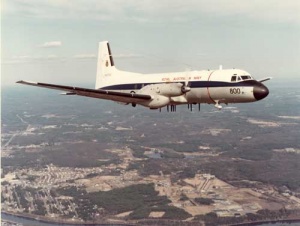The Royal Australian Navy (RAN) operated two Hawker Siddeley HS 748s which were a medium-sized turboprop 36 seat commercial airliner originally designed by the British firm Avro in the late 1950s, to replace the many aging DC-3 aircraft then in operation with many smaller airlines. Three hundred and eighty aircraft were eventually built by Hawker Siddeley. The Royal Australian Air Force (RAAF) purchased ten HS 748s, operating the aircraft from 1968 both as a navigation trainer and as part of its VIP Flight.
The Fleet Air Arm DC-3s began to be phased out in the early 1970s and were replaced by the HS 748 as the RAN navigational training aircraft. The first HS 748 arrived at Nowra in June 1973 having been ferried from the United Kingdom by RAN personnel. The second aircraft arrived in August 1973 and both were allocated to 851 Squadron.

Left: A Hawker Siddeley HS 748 conducting an electronic warfare exercise with an Oberon Class submarine. Right: An HS 748 flying over the south coast of New South Wales.
On Christmas Eve 1974 the city of Darwin was devastated by Cyclone Tracy and Operation NAVY HELP DARWIN soon swung into action. The HS 748s were involved from the start and on 26 December a Navy HS 748 became the second aircraft to arrive in the destroyed city. Over the next ten days the two HS 748s completed 14 return flights carrying 485 passengers (both moving specialist personnel into Darwin and taking evacuees out) and bringing in 23 tonnes of stores and equipment.
In January 1975 a HS 748 was dispatched from Nowra to conduct an airfield survey of north Western Australian airfields in preparation for basing Grumman Trackers on the west coast to conduct fisheries patrols for illegal Indonesian fishing vessels as part of Operation TROCHUS 75. The airfield at Broome was eventually selected and used between March and May 1975 by the Trackers.
The planned installation of electronic counter-measures (ECM) equipment was delayed until 1978 due to the high costs of the equipment. Both aircraft were flown to the United States in late 1977 to have the equipment installed. They were returned to Australia in mid-1981 once fitted out and tested. Once fitted with its ECM suite the aircraft was operated by a crew of seven (two pilots, one observer/navigator, a tactical coordinator and three ECM operators). The HS 748 became a regular sight for ships working up on the east coast where they simulated a hostile electronic warfare environment.
The aircraft could also be fitted with seating, as required, for transport duties. This came into effect in 1989 when Operation IMMUNE was activated by the Hawke Government to break the commercial pilots strike. Two HS 748s operated by just three crews, flew for four months carrying over 10 000 civilian passengers between Sydney, Canberra, Melbourne, Hobart and Launceston. The HS 748 EW Flight was later awarded the Navy League of Australia Trophy for its aid to the civil community. The two aircraft then returned to EW training duties.
The two HS 748 aircraft ceased operations with the RAN on 23 June 2000 and were sold.
Specifications
 |
| Type |
Land based electronic warfare trainer and transport aircraft |
|---|---|
| Manufacturer |
Hawker Siddeley |
| Origin |
England |
| Number Ordered |
2 |
| First Delivered |
11 June 1973 |
| Last Delivered |
20 August 1973 |
| Length |
67 feet |
| Height |
24 feet 10 inches |
| Weights | 25,516 |
| Dimensions | Wing span: 98 feet 6 inches |
| Speed | 278 mph |
| Range |
1987 miles |
| Crew |
3 |
| Engines | Two 2280 shp Rolls Royce Dart 550-2 turboprops |
| Performance |
|
| Operated by |
VC851 Squadron (1973-1984), HC723 Squadron (1984-2000) |